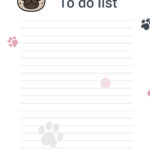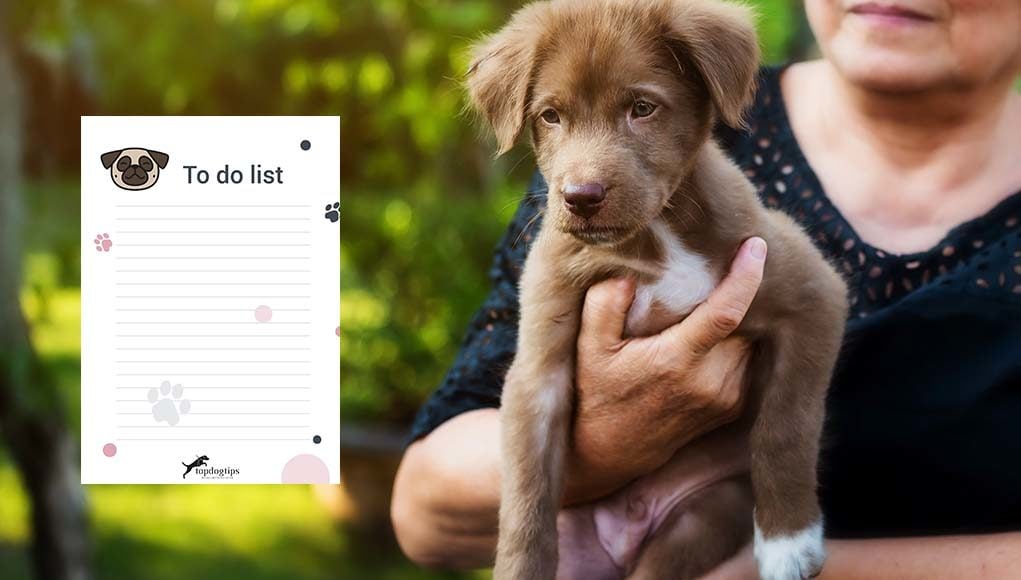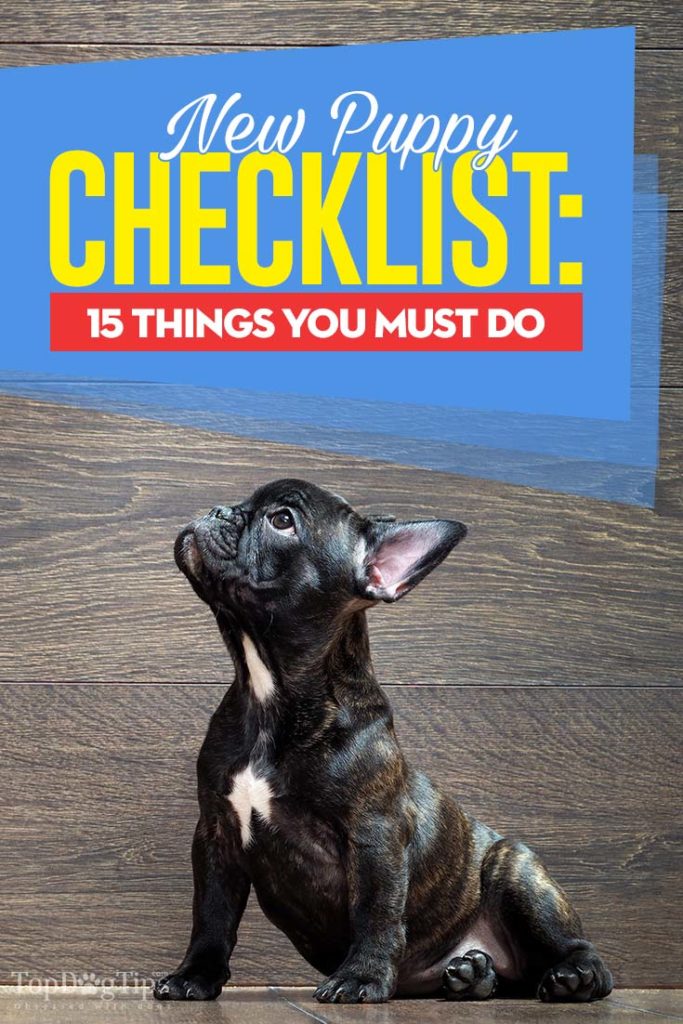Before bringing home a new puppy, there are a few things to do to make their home-coming comfortable and safe. Preparing a new puppy checklist will also decrease stress for pet owners. Below are some important items and to-dos to help you prepare to welcome home a newly adopted dog.
Table of Contents
- 15 New Puppy Checklist To-Dos
- 1. Find a Vet
- 2. Read Up on the Breed
- 3. Buy the Basics
- 4. Buy Monthly Preventatives
- 5. Get an Identification Tag
- 6. Consider a Car Harness, Booster Seat or Travel Crate
- 7. Get Any Necessary Clothing
- 8. Get Some Poop Bags
- 9. Research Local Trainers and Puppy Classes
- 10. Find a Local Emergency Vet
- 11. Talk to Your Family Members
- 12. Research Pet Insurance
- 13. (Optional) Training Aids
- 14. Choose a Name
- 15. Plan for Exercise
- Don’t Panic
To compose this new puppy checklist, we've asked a number of people on our editorial team about puppy adoption, and they ranked these to-dos in order of importance. Most dog owners mentioned these are the things they wish they would've done or knew before bringing the dog home.

Checklist Template: It's recommended you write down most of these points and hang them somewhere visible as you go through each step. If you want a new puppy checklist template for writing these the below to-dos, you can download and print our Template 1, Template 2 or Template 3. These templates are specifically designed for new puppy owners and their first tasks, and come with cute animations and paw prints.
15 New Puppy Checklist To-Dos
1. Find a Vet
Your veterinarian is going to be part of your “dog team” and it's the first point to address on a new puppy owner checklist. It’s important to do research and find a local vet before you bring a new puppy home. Visit a vet clinic shortly after, but sometimes there are unpredictable issues that arise and you don't want to be searching for a vet in panic.
Ask friends with dogs for their recommendations, read online reviews and feedback for local veterinarian clinics, tour the veterinary facility (under the precedent of asking questions) to meet the vet. This will ensure that you have a veterinarian lined up to give your new dog a complete health check as soon as you bring them home.
Make sure you also find not any veterinarian, but an actually good vet. Look for a professional who is clearly qualified, who you are comfortable talking to, who makes you feel at ease, and whose clients speak highly of when asked for a referral.
2. Read Up on the Breed
Whether you are adopting a mixed breed or buying a purebred dog from a reputable breeder, you'll have some idea of what breed of dog you're getting. The next item on new puppy checklist is to investigate the breed to find out what to expect. This will help you to determine whether you are choosing the right breed for you and prepare appropriately.
There is plenty of breed information and quizzes available online for free. For more, you can buy or lend a book to get more detailed information. If you've already have a vet, discuss the breed with them.
Pay attention to things like size, exercise requirements, common medical concerns, train-ability, sociability, and adaptability. These key characteristics will help to determine if you are adopting a breed that's compatible with your lifestyle and family.
3. Buy the Basics
Following some research, the next new puppy checklist stop is buying puppy supplies. Take a look at a new puppy's shopping list – it will get you started, but don’t go crazy with purchases. Some of the most essential dog supplies that we recommend are:
- Stainless-steel food and water bowl (steel with non-slip base is better than plastic)
- Single bag of good quality puppy food matching the puppy's previous diet
- Appropriately sized dog collar
- Dog leash
- Harness, as long as you know your new puppy’s measurements
- Optional: Dog crate if you will be crate training the dog
- Optional: Small puppy training treats, preferably low-calorie and healthy
- Optional: Pet gate to block stairways or secure your non-crated puppy
- Optional: Dog bed or a crate pad for the kennel
- Some puppy toys (durable and freezable chew toys to relieve teething are best)
- Grooming supplies to desensitize the puppy to grooming early on (we recommend a brush, dog-friendly toothpaste and toothbrush, ear wipes, and gentle dog shampoo)
You've probably researched already how much a dog cost and what other things you'll need to buy throughout your pup's life. The above new puppy owner checklist items are only the very essential stuff that are best bought before you bring your dog home.
4. Buy Monthly Preventatives
A crucial step is ensuring your new dog's health long-term. Depending on how old your puppy is, have monthly preventatives ready for the dog's protection against heartworm, fleas, ticks, and worms. It's best to wait for your first vet appointment to get these items.
Pay attention to your new puppy’s age and weight – this will influence preventative types recommended. The environment your dog will spend time in also a factor. While it's a good idea to research these things, it's best to wait until your first vet appointment before buying anything specific.
5. Get an Identification Tag
Even if you haven’t yet named your new puppy, put “ID tag” on your new puppy to-do list. Buy and customize a dog ID tag with your own name, address, and phone number and attach it to your puppy’s new collar so that they’re “tagged” after you pick them up.
You can find dog identification tags at most big name pet stores or if you prefer a custom design tag, you can visit online marketplaces like Amazon or Etsy to have one made to your specifications and be more unique.
6. Consider a Car Harness, Booster Seat or Travel Crate
Many pet owners ignore this until it's too late but protection of dogs in moving vehicles is essential. A car harness with a seat belt clip is a must if you won’t be crating your dog while traveling in a car, so put that down on your new puppy owner checklist. It's best to buy this beforehand so you can crate the dog on your way home.
There's many dog car harnesses, secure crates and booster seats, all made for travel, but we especially recommend the Sleepypod Clickit Terrain Harness, the ZuGoPet Rocketeer Pack, and the Sleepypod Clickit Sport because they've been crash-tested. Finally, a back-seat cover to keep car seats as free from dog hair may be useful, too.
In general, there are many different dog car safety products available, but car harnesses have been proven to be the safest method of car restraint. Whatever dog car harness you pick, make sure that you review crash safety testing data before purchase.
7. Get Any Necessary Clothing
Most dogs don’t require clothing of any type, but this comes down to the breed and the dog. For example, if your puppy has a skin condition that thins their coat, has a low body weight, cannot control body temperature, or have a short thin coat and it’s cold outside, then buy a dog sweater or coat so the puppy can maintain their body temperature.
Pick something that fits your pup and the environment. We've got a list of good sweaters and coats, but the most well-reviewed brand is Gooby. The company has a number of puppy clothes, and our editors love their fleece vests.
8. Get Some Poop Bags
A must for any future dog owner's new puppy checklist is some eco-friendly biodegradable poop bags. There's many brands but for their convenience, we like the handled poop bags from Pogi’s or Earth Rated because they’re easy to tie and they’re environment-friendly.
You don’t have to choose these poop bags because there's many, many other great alternatives that are just as good. Pick scented bags or bags without handles, but we certainly recommend to boy recyclable eco-friendly bags.
9. Research Local Trainers and Puppy Classes
Obedience training is a must for any dog – it gives you a chance to bond with your puppy, it lets your puppy socialize with other dogs and strangers, and it helps your puppy to understand what is expected of them which is crucial for everybody's safety.
When researching puppy class options, you probably won’t be able to attend classes right away (at least until the dog had their vaccinations). This gives you time to find local dog trainers, their methods of puppy training, and help you to decide on the best choice.
Note: If a new puppy has any behavioral concerns and requires one-on-one training with a canine behaviorist, or if you have received specific training instructions from your adoption agency or breeder, please remember to follow those recommendations.
10. Find a Local Emergency Vet
You've already found a veterinarian for regular visits and hopefully you won’t need to use an emergency vet clinic, but it’s crucial that you have one pre-selected.
Emergency vets are different from a local veterinary clinic. Puppy emergency situations can come up at any time during your dog's lifetime, but it's especially common in puppies. Treating these health issues quickly is crucial due to puppy's immature immune system.
Research emergency vet clinics, Google “emergency vet near me“, ask around for friends' recommendations, read reviews, and visit the clinic. Once selected, keep their address and phone number on your refrigerator, saved in your cell phone, mapped in your car’s GPS and inside a pet first aid kit. This way you will always have it all at the drop of a hat.
11. Talk to Your Family Members
Whether you have small children at home or adults who have never had a dog before, sit down as a family and talk about what it means to bring a new puppy home. Show them this new puppy checklist for review. Have a conversation about dog care, and touch on the below specific topics:
Responsibilities. Who will be responsible and for what duties when taking care of the new puppy? Making everyone part of caring for this new dog will reinforce the importance of taking responsibility, making commitments, and caring for living creatures.
Needs. Talk about the special needs of a new puppy and what everyone can do to help to accommodate those needs. For example, puppies need a lot of sleep during the day so it’s important not to keep waking them just to play with them. Then, review the new puppy checklist and see if anyone has any input or cautions.
Safety. For everyone's health and safety, talk with your family about canine body language. Pull up some videos on YouTube that explain different types of dog's body language and make sure that everyone is familiar with the different signals that your new puppy may display and what they mean. For example, when your new puppy holds their ears back and flat against their head and their tail is tucked underneath their body, it’s a sign that they are afraid and might display aggression. Once you have covered these different signals and what they mean, talk about what the response should be. For example, if your puppy displays signs of being afraid when your child is screaming loudly, your child should notice those signs and stop screaming loudly.
While this part of new puppy owner checklist comes at the end and can be done on the day of bringing home your new dog, it's crucial that everyone is familiar with these and other aspects of caring for a puppy properly.
12. Research Pet Insurance
Pet insurance isn’t something pet owners think about when adopting a puppy, but it’s important to consider this now, before your puppy gets older. There are many companies and different plans, so familiarize yourself with them.
![]() Read pet insurance reviews from users of the different insurance policy companies, compare plans, and ask for recommendations from friends and family. Not all pet owners will need pet insurance, so decide beforehand if you actually need it, or if you can simply use a savings account.
Read pet insurance reviews from users of the different insurance policy companies, compare plans, and ask for recommendations from friends and family. Not all pet owners will need pet insurance, so decide beforehand if you actually need it, or if you can simply use a savings account.
Consider any pre-existing dog conditions, the monthly premium, the plan’s deductible, and the type of coverage offered. There are two types of coverage available: full coverage for routine and emergency care (more expensive), and emergency coverage only (cheaper).
The biggest determining factor in which plan is right for you is your monthly dog budget. You can also purchase “add-ons” to extend coverage. For example, we often choose an insurance rider (add-on) for cancer coverage because it extends the covered amount for treatment and adds very little to your monthly bill.
13. (Optional) Training Aids
As a separate part of a new dog checklist to buying the essentials, dog training aids may or may not be necessary. Depending on your approach to puppy training, there's multiple training aids beneficial for doing this task easier and faster. These include potty chimes or doorbells, clickers, pee pads, and extended long-run leashes, just to name a few.
14. Choose a Name
It might sound like a trivial part of a new dog owner checklist, but it’s important to condition your dog to respond to their name as soon as possible. By deciding on a name for your new puppy before they come home, you can start exposing them to that name as soon as you leave the shelter or breeder.
15. Plan for Exercise
Exercise isn’t just a chore – it’s a crucial part of your puppy’s healthy development, mental and physical well-being. Plan out what type of daily exercise you will provide, who will be responsible for exercising the puppy, and if the main trainer is ill, who will take over?
Your dog's exercise and playtime needs, mental stimulation requirements and more will depend on the breed, specific age and health condition. This is part of “breed research” mentioned above, but it's good to create a separate puppy exercise plan, too.
Don’t Panic
If this is the first time you're adopting a dog and doing a new puppy checklist, and it looks overwhelming – do not panic. It's true that bringing a new pooch home requires a ton of pre-planning, but you're already ahead of many pet owners on impulse and don't prepare.
Following the to-dos on this new puppy owner checklist and with a little organization, you will soon have your freshly adopted dog safely home and settled in with a regular routine in place, and it won't take longer than a week or two.
READ NEXT: 15 Tips on Pet Proofing Your Home in Preparation for a New Dog
Disclosure: We may earn affiliate commissions at no cost to you from the links on this page. This did not affect our assessment of products. Read more here and find full disclosure here.















